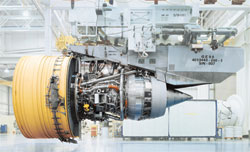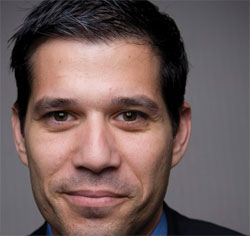The Mini-Cases: 5 Companies, 5 Strategies, 5 Transformations
From repositioning an entire organization to rethinking design approaches, supply chains and government collaborations, sustainability-related concerns are prompting many businesses to make major shifts. Here are mini-case glimpses of Nike, Rio Tinto, GE, Better Place and Wal-Mart.
Sustainability isn’t a one-size-fits all strategy that a company can implement by following a set of rules. Rather, it springs from challenges each company faces in its own markets. Take Nike Inc., whose brand is synonymous with cutting-edge design. As part of its strategy to reduce the amount of material in its shoes, and thus waste, redesigning the athletic shoe became a core element of its approach to sustainability.
The Leading Question
What changes when a company acts on sustainability?
Findings
- Strategies differ widely, according to the unique challenges or opportunities each company confronts.
- First steps always lead to unexpected further options.
- Actions often lead to new sources of competitive advantage.
To be sure, there are common elements in how companies try to capitalize on sustainability — reducing energy consumption, lowering carbon footprints and becoming more efficient consumers of water, less wasteful manufacturers and more thoughtful corporate citizens. But the specific path each company takes depends on what it views as most critical to its business. For a start-up like Better plc, LLC, an electric vehicle provider based in Palo Alto, California, that might mean locating in countries around the world most receptive to the electric car business. For Wal-Mart Stores Inc., sustainability might mean greening the supply chain.
But one thing is certain: Sustainability is less a target than an approach, which is why it is continually being refined. As companies ramp up understanding, they also push the envelope of what can be accomplished. In short, learning more about what they do has led companies to change how they do it.
Though it takes investment and commitment, the rewards are measured in energy cost savings, new product design, customer engagement and employee commitment. Together, all these attributes amount to the one thing any business understands: competitive advantage.

Courtesy of Nike
Nike
From Labor-Practice Compliance to Design Offensive
Backstory: Stung by a campaign against its labor practices in the 1990s, Nike embarked on a long process to ultimately reinvent its operations and meet broad sustainability metrics by 2020.
Challenge: Can you move beyond “compliance” and capitalize on sustainability by integrating it into the fabric of a company — from design and manufacturing to the supply chain?
Key moves: Nike began taking a deep look at its operations in the early 1990s, after it faced a firestorm of criticism over labor practices at its Asian suppliers. The early efforts were siphoned to a team focused on compliance and social responsibility.
A turning point came when the team began to ask about the long-term implications of the company’s product design and manufacturing decisions. Where did the product materials come from? Were they toxic? What happened at the end of a product’s life? Looking into manufacturing, they found it took three shoes’ worth of material to produce just two — one shoe, in effect, ended up as waste, at a cost of $700 million a year. As a result, the goal of zero waste got the attention of senior managers. It became one of several long-term goals to reach by 2020 — along with zero toxic materials, closed loop systems and sustainable growth and profitability. Nike also created an in-house index to measure product design against these goals.
The company brought partners into the process, like Dow Chemical, DuPont and BASF, because it knew it could not achieve its goals without working within the supply chain.
Then it began reinventing the design process. If the athletic shoe were streamlined to cut waste and material by reducing the number of components, production efficiencies could offset the cost of more sustainable materials.
Impact: Nike began implementing zero waste and streamlined production around its Considered line of athletic footwear and apparel. That leading-edge line now comprises 15% of its products. The company aims to convert all athletic shoes to its Considered Design standards by 2011, all clothing by 2015, and all equipment like balls, gloves and backpacks by 2020. Under the new design and production methods, these products reduce waste by up to 67%, cut energy use by 37% and slash solvent use by 80% compared with other Nike products.

Courtesy of General Electric
General Electric
An Opportunistic Push Into Sustainable Business
Backstory: General Electric Co. decided sustainability was a business opportunity rather than a cost and pushed into the field in 2005 with its ecomagination initiative. But the products and services weren’t only for its customers — they first transformed GE.
Challenge: How do you create a new business in sustainability and move into the major leagues?
Key moves: GE began looking at sustainability as part of a demographic trend, realizing that scarcity would increase with population growth. Energy and water use, waste, carbon emissions — all would decline among the most efficient and sustainable companies. GE saw a profitable business opportunity in helping companies along this sustainable path. So it set up its ecomagination unit to offer environmental solutions.
GE also gambled that carbon would eventually be a cost, following the implementation of previous regulatory regimes such as limiting acid rain. Although the precise way carbon would be regulated was unknown, as it still is, the company had little doubt that regulation would come to pass. Rather than wait, GE joined a climate coalition with nongovernmental organizations to press for a cap-and-trade system in order to build certainty into the future.
Within the company, GE began engaging employees to see where energy savings could be found. That might include turning off the lights when a factory was idle or even installing a switch so that lights could be turned off. Ecomagination sold solutions within GE, whether the project involved installing LED lights on a factory floor, recycling water at a nuclear facility or offering combined heat and power generation units at a plant in Australia. Within GE, managers began to be measured on how much energy savings they had achieved.
Impact: The company so far has saved $100 million from these measures and cut its greenhouse gas intensity — a measure of emissions against output — by 41%, according to the company’s sustainability report. The work inside GE became a proof of concept to external customers grappling with similar issues. Ecomagination targeted C-level executives to build this business, since most problems cut across divisions (improving energy efficiency, for example).
So far GE has invested $4 billion in this effort, much of it in research and development. But it reaped sales of $17 billion in 2008, up 21% from a year earlier, and is striving for $25 billion in sales in 2010.

Courtesy of Rio Tinto
Rio Tinto
Mining the Social Dimensions of Its Vast Operations
Backstory: Given its business of mining over 5 million tons of rock a day, Rio Tinto has a big footprint. The mines are expensive, take decades to fully develop and are not portable if something goes wrong. To reduce the political and economic risk and thus ensure steady returns, Rio Tinto has sought to win the backing of local communities, governments and the societies in which it operates.
Challenge: How does a company obtain a “social license” to operate, and nurture the local labor force that it needs?
Key moves: About a decade ago, Rio Tinto came up with the concept of working within communities on outreach and social and economic development. At the time, the company was developing a mine in Madagascar that was a source of contention with NGOs, which were worried about threats to biodiversity and the local community. Ninety percent of the island had already been cleared by farming, grazing and charcoal production; the mine was situated in one of the island’s last pristine regions. The challenge was to create an operation “respectful to the environment, respectful of our employees, that is seen to be sustainable,” said CEO Tom Albanese.
A plan was developed to protect the environment and create economic opportunities in the communities surrounding the project, setting up standards and goals for the company to meet. These in turn aligned with broader company policies on environmental stewardship, social well-being, governance and economic prosperity.
Putting this strategy to work, Rio Tinto created a long list of measures, including:
- Policies to protect biodiversity and water quality around mine locations
- Employment for aboriginal peoples living near its mines
- Training programs to shift employees from manual labor to skilled positions
- Plans for the day when mining would be done, seeking to prevent “ghost towns”
- Goals for greenhouse gas emissions and energy use
Impact: Through these coordinated initiatives, Rio Tinto has obtained what it calls a “social license to operate.” The company felt an urgency because it recognized a global brand risk if it operated without such a license. Rio Tinto also helped form the International Council on Mining & Metals, which encourages sustainable practices across the mining sector.

Courtesy of Better Placec
Better Place
Charging Ahead in Favorable Regulatory Climates
Backstory: Better Place saw a future in electric cars and a demand for ways to recharge them. But how soon will electric charging stations make sense?
Challenge: What’s the fastest way to bring the electric “filling station” — a technology of the future — to market?
Key moves: Shai Agassi founded Better Place in 2007 on a straightforward rationale: Oil is finite, petroleum prices will inevitably rise and global warming has created the impetus to reduce carbon emissions. Electric cars will be part of the emissions-reduction answer, as long as they have refilling stations.
Still, there was a big gap between that knowledge and the kind of favorable policies needed to create a critical mass of electric cars, at least in most markets.
So Better Place decided to analyze which geographic areas had already made political and cultural strides toward favoring electric vehicles — in essence, “outsourcing” its work on regulatory policy change to communities in which it was already underway.
Among Better Place’s criteria for identifying hospitable locations for operation were that the public had to be receptive to electric cars, therefore creating an underlying market, and the government had to be creating a political climate to bring electric transportation to life. At the top of its list of nations was Israel, which wants all new cars to be electric by 2020. Urban centers in Israel are also less than 150 kilometers apart (about 90 miles), and 90% of car owners drive less than 70 kilometers per day, perfect for a short-haul electric vehicle. Add on gasoline taxes and a burgeoning wind industry, and Israel appeared the perfect habitat to nurture electric vehicles — and thus electric refilling stations.
Coming in a close second was Denmark, which has a strong green consumer movement and has committed to cutting carbon emissions by 21% by 2012. Better Place also partnered with the city of Copenhagen for the rapid deployment of electric recharging stations. In addition to these two leading-edge countries, the company is working in Australia, the United States (Los Angeles) and Japan to roll out recharging stations.
Impact: By identifying favorable locations, Better Place is accruing a competitive advantage in removing a major barrier to the widespread adoption of electric cars. It has also positioned itself to be the first to reap the benefits when battery pack recharging facilities and infrastructure are more universally accepted, by having proof of concept in hand in leading-edge nations.

Image courtesy of Wal-Mart
Wal-Mart
Repurposing the Supply Chain
Backstory: Wal-Mart, the largest retailer in the world, with over 7,800 stores, has been working steadily to improve sustainability. From installing green roofs to rolling out a more efficient trucking fleet, the company has moved forward internally, but now it is bringing its suppliers along.
Challenge: How do you green the supply chain?
Key moves: Wal-Mart has been pushing sustainability since adopting the strategy in 2005, establishing goals of being 100% fueled by renewable energy, producing zero waste and selling products that will sustain the environment.
So how does that happen? In one famous example, the company began working with Unilever plc in 2005 to sell concentrated laundry detergent in a 32-ounce container (equivalent to 100 ounces under a previous formulation). Consumers got a more powerful detergent in a smaller package. Three years after rollout, the new container had saved 80 million pounds of plastic resin, 430 million gallons of water and 125 million pounds of cardboard, according to a company fact sheet. More importantly, it became an industry standard, prompting other packaged goods companies to switch to concentrated detergent as well.
Wal-Mart’s zero waste initiative is also moving forward. The company, which is aiming to eliminate all its landfill waste by 2025, was able to reduce waste by 57% between 2008 and 2009. It did so by improving inventory management, increasing donations and ramping up recycling (including 25 billion pounds of cardboard).
Now it is striving to push these criteria down into the supply chain on a three-stage path. First, it wants suppliers to rate their products on sustainability criteria. Second, it wants to gather data on product life cycles. Third, it is creating a sustainability index that will increase transparency for the consumer.
The first initiative, rolled out earlier this year, involves a questionnaire sent to more than 100,000 suppliers. It polls them on four categories: their energy and greenhouse gas emissions, waste and quality initiatives, “responsibly sourced” materials and ethical production.
Products are also being measured through their life cycles. Collaborating with academics, retailers, NGOs, suppliers and government in a consortium, Wal-Mart’s goal is to build a global database of product information. As environmental business consultant Joel Makower wrote on his blog, http://makower.typepad.com, “the consortium’s mandate is to focus on how to evaluate products, which Wal-Mart hopes will become the basis for standards, ratings, or other product-level evaluations that it would use in its stores.”
That data will be used to develop an index consumers can use to evaluate products, though it’s still unclear how that information will be measured and presented. Nor is there a timeline for rolling out such an index.
Impact: Wal-Mart wants its sustainability index to be open to all, becoming a standard to measure and communicate the green credentials of a product and thus becoming “a tool for sustainable consumption.” In the process, the exercise of measurement itself may reap rewards in more efficient production, less waste and lower emissions — all of which are also cost-saving measures.

Comment (1)
I Siverson